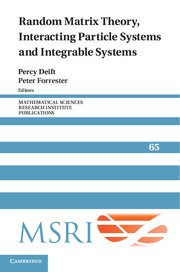Book contents
- Frontmatter
- Contents
- Preface
- Universality conjecture for all Airy, sine and Bessel kernels in the complex plane
- On a relationship between high rank cases and rank one cases of Hermitian random matrix models with external
- Riemann–Hilbert approach to the six-vertex model
- CLT for spectra of submatrices of Wigner random matrices, II: Stochastic evolution
- Critical asymptotic behavior for the Korteweg–de Vries equation and in random matrix theory
- On the asymptotics of a Toeplitz determinant with singularities
- Asymptotic analysis of the two-matrix model with a quartic potential
- Conservation laws of random matrix theory
- Asymptotics of spacing distributions 50 years later
- Applications of random matrix theory for sensor array imaging with measurement noise
- Convolution symmetries of integrable hierarchies, matrix models and τ-functions
- Universality limits via “old style” analysis
- Fluctuations and large deviations of some perturbed random matrices
- Three lectures on free probability
- Whittaker functions and relatedstochastic processes
- How long does it take to compute the eigenvalues of a random symmetric matrix?
- Exact solutions of the Kardar–Parisi–Zhang equation and weak universality for directed random polymers
- Replica analysis of the one-dimensional KPZ equation
- Asymptotic expansions for β matrix models and their applications to the universality conjecture
- KPZ scaling theory and the semidiscrete directed polymer model
- Experimental Realization Of Tracy–Widom Distributions And Beyond: Kpz Interfaces In Turbulent Liquid Crystal
- Random matrices: the four-moment theorem for Wigner ensembles
On the asymptotics of a Toeplitz determinant with singularities
Published online by Cambridge University Press: 29 May 2025
- Frontmatter
- Contents
- Preface
- Universality conjecture for all Airy, sine and Bessel kernels in the complex plane
- On a relationship between high rank cases and rank one cases of Hermitian random matrix models with external
- Riemann–Hilbert approach to the six-vertex model
- CLT for spectra of submatrices of Wigner random matrices, II: Stochastic evolution
- Critical asymptotic behavior for the Korteweg–de Vries equation and in random matrix theory
- On the asymptotics of a Toeplitz determinant with singularities
- Asymptotic analysis of the two-matrix model with a quartic potential
- Conservation laws of random matrix theory
- Asymptotics of spacing distributions 50 years later
- Applications of random matrix theory for sensor array imaging with measurement noise
- Convolution symmetries of integrable hierarchies, matrix models and τ-functions
- Universality limits via “old style” analysis
- Fluctuations and large deviations of some perturbed random matrices
- Three lectures on free probability
- Whittaker functions and relatedstochastic processes
- How long does it take to compute the eigenvalues of a random symmetric matrix?
- Exact solutions of the Kardar–Parisi–Zhang equation and weak universality for directed random polymers
- Replica analysis of the one-dimensional KPZ equation
- Asymptotic expansions for β matrix models and their applications to the universality conjecture
- KPZ scaling theory and the semidiscrete directed polymer model
- Experimental Realization Of Tracy–Widom Distributions And Beyond: Kpz Interfaces In Turbulent Liquid Crystal
- Random matrices: the four-moment theorem for Wigner ensembles
Summary
We provide an alternative proof of the classical single-term asymptotics for Toeplitz determinants whose symbols possess Fisher–Hartwig singularities. We also relax the smoothness conditions on the regular part of the symbols and obtain an estimate for the error term in the asymptotics. Our proof is based on the Riemann–Hilbert analysis of the related systems of orthogonal polynomials and on differential identities for Toeplitz determinants. The result discussed in this paper is crucial for the proof of the asymptotics in the general case of Fisher–Hartwig's singularities and extensions to Hankel and Toeplitz+Hankel determinants.
1. Introduction
Let f(z) be a complex-valued function integrable over the unit circle. Denote its Fourier coefficients
We are interested in the n-dimensional Toeplitz determinant with symbol f( z),
where f (ei θ) has a fixed number of Fisher–Hartwig singularities [Fisher and Hartwig 1968; Lenard 1964; 1972], i.e., f has the following form on the unit circle:
for some m = 0; 1; : : : , where
and V(ei θ) is a sufficiently smooth function on the unit circle (see below). The condition on the _j insures integrability. Note that a single Fisher–Hartwig singularity at z j consists of a root-type singularity
and a jump eiπ βWe assume that zj, j =1,...,m, are genuine singular points, i.e., either j or βj=0. However, we always include z0=1 explicitly in (1-2), even when _0 = β=0 : this convention was adopted in [Deift et al. 2011] in order to facilitate the application of our Toeplitz methods to Hankel determinants. Note that gβo(z)= e(-iπβ0). Observe that for each j≠0, zβjgβj(z) is continuous at z=1, and so for each j each “beta” singularity produces a jump only at the point zj. The factors zj-βθ are singled out to simplify comparisons with the existing literature. Indeed, (1-2) with the notation b(θ) = eV(eiθ) is exactly the symbol considered in [Fisher and Hartwig 1968; Basor 1978; 1979; Böttcher and Silbermann 1981; 1985; 1986; Ehrhardt and Silbermann 1997; Ehrhardt 2001; Widom 1973]. However, we write the symbol in a form with zΣmj=0βj factored out. The representation (1-2) is more natural for our analysis.
Information
- Type
- Chapter
- Information
- Publisher: Cambridge University PressPrint publication year: 2014
Accessibility standard: Unknown
Why this information is here
This section outlines the accessibility features of this content - including support for screen readers, full keyboard navigation and high-contrast display options. This may not be relevant for you.Accessibility Information
- 6
- Cited by
